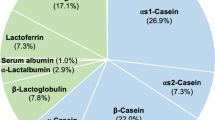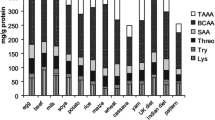Abstract
Purpose
To determine tocopherol and fat content of Greek mother’s milk during the first 6 months of exclusive breastfeeding and correlate with maternal diet characteristics.
Methods
Milk samples and dietary records were obtained by mothers at 1st (n = 64), 3rd (n = 39) and 6th (n = 23) month postpartum. Milk tocopherol content was determined by high-performance liquid chromatography method (HPLC) and fat content by the crematocrit method.
Results
Milk’s α-tocopherol content at 1st, 3rd and 6th month postpartum was 8.3 ± 3.4, 8.1 ± 4.2 and 8.5 ± 4.7 μmol/L, while total tocopherol values were 8.9 ± 3.6, 8.7 ± 4.6 and 9.5 ± 5.6 μmol/L, respectively, and were closely related to milk’s fat content. No significant differences were observed for α- and total tocopherol content in breast milk among the three time points. Maternal vitamin E dietary intake was 7.2 ± 3.7, 6.8 ± 3.5 and 10.9 ± 5.2 mg/day at 1st, 3rd and 6th month postpartum, respectively. Though vitamin E dietary intake was less than the recommended one, vitamin E content in breast milk was considered sufficient for infant needs. Milk tocopherol content was found to be associated only with mothers’ total fat and saturated fat dietary intake.
Conclusion
This study is among few in literature to determine tocopherol content of breast milk in European women and detect dietary factors that may influence its values. The only maternal dietary characteristic to affect breast milk tocopherol content was mothers’ total fat intake, while tocopherol intake seems to have no effect.
Similar content being viewed by others
References
Jansson L, Akesson B, Holmberg L (1981) Vitamin E and fatty acid composition of human milk. Am J Clin Nutr 34:8–13
Blatt DH, Leonard SW, Traber MG (2001) Vitamin E kinetics and the function of tocopherol regulatory proteins. Nutrition 17:799–805
Brigelius-Flohe R, Traber MG (1999) Vitamin E: function and metabolism. FASEB J 13:1145–1155
Traber MG, Kayden HJ (1989) Preferential incorporation of alpha-tocopherol vs. gamma-tocopherol in human lipoproteins. Am J Clin Nutr 49:517–526
Desai ID, Machlin LJ (1985) Vitamin E. In: Augustin J, Klein BP, Becker S, Venugopal PB (eds) Methods of vitamin assay, 4th edn. New York, Wiley, pp 255–281
Traber MG, Rader D, Acuff RV, Brewer HB Jr, Kayden HJ (1994) Discrimination between RRR and all-racemic-a-tocopherols labeled with deuterium by patients with abetalipoproteinemia. Atherosclerosis 108:27–37
Traber MG (2006) Vitamin E. In: Shils ME, Shike M, Ross AC, Caballero B, Cousins R (eds) Modern nutrition in health and disease, 10th edn. Lippincott Williams & Wilkins, Baltimore, pp 396–411
Escrivá A, Esteve MJ, Farré R, Frígola A (2002) Determination of liposoluble vitamins in cooked meals, milk and milk products by liquid chromatography. J Chromatogr A 947(2):313–318
Crawford MA, Golfetto I, Ghebremeskel K, Min Y, Moodley T, Poston L (2003) The potential role for arachidonic and docosahexaenoic acids in protection against some central nervous system injuries in preterm infants. Lipids 38:303–315
Romeu-Nadal M, Morera-Pons S, Castellote AI, López-Sabater MC (2006) Determination of gamma- and alpha-tocopherols in human milk by a direct high-performance liquid chromatographic method with UV-vis detection and comparison with evaporative light scattering detection. J Chromatogr A 1114(1):132–137
Brion LP, Bell EF, Raghuveer TS (2003) Vitamin E supplementation for prevention of morbidity and mortality in preterm infants. Cochrane Database Syst Rev;4:CD003665
WHO (2003) Evidence on the long-term effects of breastfeeding. Systematic reviews and meta-analysis. Department of child and adolescent health and development, Switzerland
Worthington-Roberts B (1997) The role of maternal nutrition in the prevention of birth defects. J Am Diet Assoc 97(10 Suppl 2):S184–S185
Kolb E (1995) The significance of vitamin A for the immune system. Berl Munch Tierarztl Wochenschr 108(10):385–390
Chávez-Servína JL, Castellotea AI, Riverob M, López-Sabater MC (2008) Analysis of vitamins A, E and C, iron and selenium contents in infant milk-based powdered formula during full shelf-life. Food Chem 3:1187–1197
Fidler N, Salobir K, Stibilj V (2000) Fatty acid composition of human milk in different regions of Slovenia. Ann Nutr Metab 44(5–6):187–193
Allen JC, Keller RP, Archer P, Neville MC (1991) Studies in human lactation: milk composition and daily secretion rates of macronutrients in the first year of lactation. Am J Clin Nutr 54(1):69–80
Nommsen LA, Lovelady CA, Heinig MJ, Lönnerdal B, Dewey KG (1991) Determinants of energy, protein, lipid, and lactose concentrations in human milk during the first 12 mo of lactation: the DARLING study. Am J Clin Nutr 53(2):457–465
Meneses F, Trugo NMF (2005) Retinol, β-carotene and lutein + zeaxanthin in the milk of Brazilian nursing women: associations with plasma concentrations and influences of maternal characteristics. Nutr Res 25:443–451
Ortega RM, Andres P, Martinez RM, Lopez-Sobaler AM (1997) Vitamin A status during the third trimester of pregnancy in Spanish women: influence on concentrations of vitamin A in breast milk. Am J Clin Nutr 66:564–568
de Azeredo VB, Trugo NM (2008) Retinol, carotenoids, and tocopherols in the milk of lactating adolescents and relationships with plasma concentrations. Nutrition 24(2):133–139
Campos JM, Paixão JA, Ferraz C (2007) Fat-soluble vitamins in human lactation. Int J Vitam Nutr Res 77(5):303–310
Ortega RM, Lopez-Sobaler AM, Andres P, Martinez RM, Quintas ME, Requejo AM (1999) Maternal vitamin E status during the third trimester of pregnancy in Spanish women: influence on breast milk vitamin E concentration. Nutr Res 19(1):25–36
Schweigert FJ, Bathe K, Chen F, Büscher U, Dudenhausen JW (2004) Effect of the stage of lactation in humans on carotenoid levels in milk, blood plasma and plasma lipoprotein fractions. Eur J Nutr 43:39–44
Gossage CP, Deyhim M, Yamini S, Douglass LW, Moser-Veillon PhB (2002) Carotenoid composition of human milk during the first month postpartum and the response to b-carotene supplementation. Am J Clin Nutr 76:193–197
Macias C, Schweigert FJ (2001) Changes in the concentration of carotenoids, vitamin A, alpha-tocopherol and total lipids in human milk throughout early lactation. Ann Nutr Metab 45(2):82–85
Boersma ER, Offringa PJ, Muskiet FA, Chase WM, Simmons IJ (1991) Vitamin E, lipid fractions, and fatty acid composition of colostrum, transitional milk, and mature milk: an international comparative study. Am J Clin Nutr 53:1197–1204
Comstock GW, Alberg AJ, Helzlsouer KJ (1993) Reported effects of long-term freezer storage on concentrations of retinol, beta-carotene, and alpha-tocopherol in serum or plasma summarized. Clin Chem 39(6):1075–1078
Saarela T, Kokkonen J, Koivisto M (2005) Macronutrient and energy contents of human milk fractions during the first six months of lactation. Acta Paediatr 94:1176–1181
Schweigert FJ, Hurtienne A, Bathe K (2000) Improved extraction procedure for carotenoids from human milk. Int J Vitam Nutr Res 70(3):79–83
Andrikopoulos NK, Bruschweiler H, Felber H, Taeschler Ch (1991) HPLC analysis of phenolic antioxidants, tocopherols and triglycerides. J Am Oil Chem Soc 68:359–364
Lucas A, Gibbs JA, Lyster RL, Baum JD (1978) Creamatocrit: simple clinical technique for estimating fat concentration and energy value of human milk. Br Med J 1:1018–1020
Bates CJ, Prentice A (1994) Breast milk as a source of vitamins, essential minerals and trace elements. Pharmacol Ther 62(1–2):193–220
National Institute of Health (2002) Dietary reference intakes for vitamin a, vitamin k, arsenic, boron, chromium, copper, iodine, iron, manganese, molybdenum, nickel, silicon, vanadium, and zinc. A report of the panel on micronutrients, subcommittees on upper reference levels of nutrients and of interpretation and uses of dietary reference intakes, and the standing committee on the scientific evaluation of dietary reference intakes. Food and Nutrition Board, Institute of Medicine, National Academy Press, Washington, DC
National Research Council (1989) Recommended dietary allowances. Subcommittee on the tenth edition of the RDAs. Food and Nutrition Board Commission on Life Sciences, 10th edn. National Academy Press, Washington, DC
Institute of Medicine (2000) Dietary reference intakes for vitamin C, vitamin E, selenium, and carotenoids. Food and Nutrition Board. National Academy Press, Washington, DC, pp 186–283
Anderson DM, Pittard WB (1985) Vitamin E and C concentrations in human milk with maternal megadosing: a case report. J Am Diet Assoc 85:715–717
Murphy SP, Abrams BF (1993) Changes in energy intakes during pregnancy and lactation in a national sample of US women. Am J Public Health 83(8):1161–1163
Schiff E, Friedman SA, Stampfer M, Kao L, Barrett PH, Sibai BM (1996) Dietary consumption and plasma concentrations of vitamin E in pregnancies complicated by preeclampsia. Am J Obstet Gynecol 175((4 Pt1)):1024–1028
Antal M, Regoly-Merei A, Varsanui H, Biro L, Sagi K, Molnar DV et al (1997) Nutritional survey of pregnant women in Hungary. Int J Vitam Nutr Res 67:115–122
Black AE, Wiles SJ, Paul AA (1986) The nutrient intakes of pregnant and lactating mothers of good socio-economic status in Cambridge, UK: some implications for recommended daily allowances of minor nutrients. Br J Nutr 56(1):59–72
de Pee S, West CE, Muhilal D, Karyadi D, Hautvast JGAJ (1995) Lack of improvement in vitamin A status with increased consumption of dark-green leafy vegetables. Lancet 346:75–81
Olafsdottir AS, Wagner KH, Thorsdottir I, Elmadfa I (2001) Fat-soluble vitamins in the maternal diet, influence of cod liver oil supplementation and impact of the maternal diet on human milk composition. Ann Nutr Metab 45(6):265–272
Kanno C, Kobayashi H, Yamauchi K (1989) Transfer of orally administered alpha-tocopherol into human milk. J Nutr Sci Vitaminol 35(6):649–653
Bondia-Pons I, Serra-Majem L, Castellote AI, López-Sabater MC (2007) Compliance with the European and national nutritional objectives in a Mediterranean population. Eur J Clin Nutr 61(12):1345–1351
Trichopoulou A, Psaltopoulou T, Orfanos P, Hsieh CC, Trichopoulos D (2007) Low-carbohydrate-high-protein diet and long-term survival in a general population cohort. Eur J Clin Nutr 61(5):575–581
Muskiet FA, Hutter NH, Martini IA, Jonxis JH, Offringa PJ, Boersma ER (1987) Comparison of the fatty acid composition of human milk from mothers in Tanzania, Curacao and Surinam. Hum Nutr Clin Nutr 41(2):149–159
Muskiet FA, Offringa PJ, Boersma ER (1988) Lipid content and fatty acid composition of human milk in relation to developing countries. In: Boersma ER, Huisjes HJ, Poortman HMC (eds) A holistic approach to perinatal care and the prevention of handicap. Erven B van der Kamp Publishers, Groningen, The Netherlands, pp 294–305
Tijerina-Sáenz A, Innis SM, Kitts DD (2009) Antioxidant capacity of human milk and its association with vitamins A and E and fatty acid composition. Acta Paediatr 98(11):1793–1798
Conflict of interest
The authors declare that there are no conflicts of interest.
Author information
Authors and Affiliations
Corresponding author
Rights and permissions
About this article
Cite this article
Antonakou, A., Chiou, A., Andrikopoulos, N.K. et al. Breast milk tocopherol content during the first six months in exclusively breastfeeding Greek women. Eur J Nutr 50, 195–202 (2011). https://doi.org/10.1007/s00394-010-0129-4
Received:
Accepted:
Published:
Issue Date:
DOI: https://doi.org/10.1007/s00394-010-0129-4




